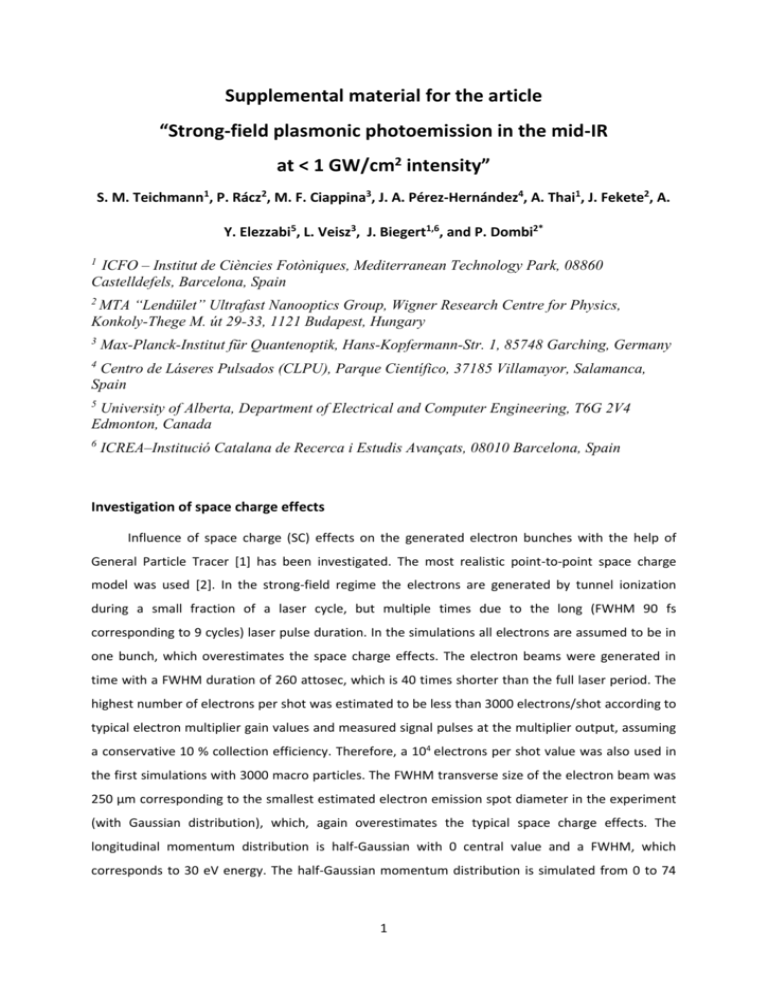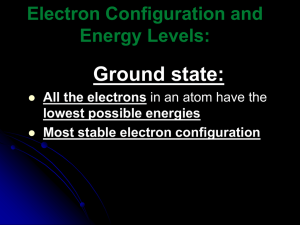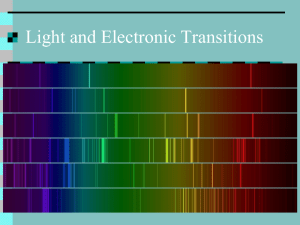Supplemental material for the article “Strong
advertisement

Supplemental material for the article “Strong-field plasmonic photoemission in the mid-IR at < 1 GW/cm2 intensity” S. M. Teichmann1, P. Rácz2, M. F. Ciappina3, J. A. Pérez-Hernández4, A. Thai1, J. Fekete2, A. Y. Elezzabi5, L. Veisz3, J. Biegert1,6, and P. Dombi2* 1 ICFO – Institut de Ciències Fotòniques, Mediterranean Technology Park, 08860 Castelldefels, Barcelona, Spain MTA “Lendület” Ultrafast Nanooptics Group, Wigner Research Centre for Physics, Konkoly-Thege M. út 29-33, 1121 Budapest, Hungary 2 3 Max-Planck-Institut für Quantenoptik, Hans-Kopfermann-Str. 1, 85748 Garching, Germany 4 Centro de Láseres Pulsados (CLPU), Parque Científico, 37185 Villamayor, Salamanca, Spain 5 University of Alberta, Department of Electrical and Computer Engineering, T6G 2V4 Edmonton, Canada 6 ICREA–Institució Catalana de Recerca i Estudis Avançats, 08010 Barcelona, Spain Investigation of space charge effects Influence of space charge (SC) effects on the generated electron bunches with the help of General Particle Tracer [1] has been investigated. The most realistic point-to-point space charge model was used [2]. In the strong-field regime the electrons are generated by tunnel ionization during a small fraction of a laser cycle, but multiple times due to the long (FWHM 90 fs corresponding to 9 cycles) laser pulse duration. In the simulations all electrons are assumed to be in one bunch, which overestimates the space charge effects. The electron beams were generated in time with a FWHM duration of 260 attosec, which is 40 times shorter than the full laser period. The highest number of electrons per shot was estimated to be less than 3000 electrons/shot according to typical electron multiplier gain values and measured signal pulses at the multiplier output, assuming a conservative 10 % collection efficiency. Therefore, a 104 electrons per shot value was also used in the first simulations with 3000 macro particles. The FWHM transverse size of the electron beam was 250 µm corresponding to the smallest estimated electron emission spot diameter in the experiment (with Gaussian distribution), which, again overestimates the typical space charge effects. The longitudinal momentum distribution is half-Gaussian with 0 central value and a FWHM, which corresponds to 30 eV energy. The half-Gaussian momentum distribution is simulated from 0 to 74 1 eV. The angular distribution was homogeneous with a divergence of 0.2 rad and azimuthally homogeneous. Figure S1. Spectrum of the electron bunch 5 ns after generation without (black, solid) and with space charge (SC) effects using 10 4 (red, dashed) and 106 (blue, dotted) electrons. The spectrum without SC is multiplied by 0.3 and spectrum with SC and 106 electrons is multiplied by 0.03 for better visibility. Figure S1 shows the spectra without space charge effects in black, solid and with SC effects and 104 electrons in red, dashed. The space charge effects do not influence the electron spectrum. As a reference simulation 106 electrons with 104 macro particles were also studied, which corresponds to 100 times larger electron number than the maximum that was conservatively estimated for the experiment. The spectrum is shown in blue, dotted line in Fig. S1. The influence of SC is serious, indicated by the shift of the spectral maximum from 0 eV to 3 eV electron energy and the significant shift of the cutoff to higher values by some 30 eV. The SC influence on the electron spatial distribution is plotted in Fig. S2. Without SC (black) and with SC and 104 electrons (red) the distributions are practically the same. In the case of 106 electrons the bunch is transversally as well as longitudinally exploded and its dimensions are visibly larger than the original sizes without SC. Simulations with 105 electrons show no visible change in the spectrum and slight transverse extension of the spatial electron distribution around the prism surface (z=0). 2 Figure S2. Spatial distribution of electrons without (black) and with space charge using 104 (red) and 106 (blue) electrons. The 0 position in z direction corresponds to the surface of the prism. No visible space charge effects are observed with 10 4 electrons per shot, representing an upper boundary for the electron number in the experiments. As a summary the SC effects have clearly no influence on the electrons and their spectrum in the conducted experiments. Summary of simulation parameters: 104 (3000) and 106 (104) electrons (macro particles) 260 attosec FWHM bunch duration with Gaussian temporal distribution corresponding to tunnel photoemission in one cycle 250 µm FWHM electron emission spot size with Gaussian transverse spatial distribution Half-Gaussian z momentum distribution with 0 average and a momentum corresponding to 30 eV FWHM from 0 to 1.44 FWHM 0.2 rad divergence with homogeneous distribution References [1] http://www.pulsar.nl/gpt [2] G. Pöplau, U. van Rienen, S. B. van der Geer and M. J. de Loos, IEEE Trans. Magn. 40, 714 (2004). 3








